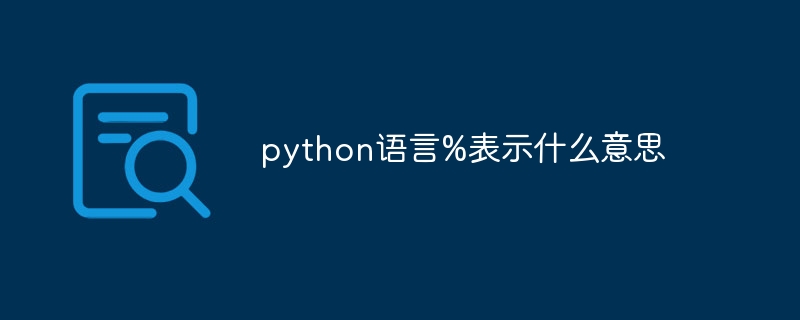
Python language % is a special operator used for string formatting that can insert the value of a variable into a specific position in the string to create dynamic string output. The % operator can be used with formatted strings to insert the value of a variable into the placeholder position in the string. The placeholder is specified by the characters after %. Different placeholders correspond to different data types. In addition to basic string formatting, the % operator also supports more formatting options, which can control the display format of inserted values, etc.

Operating system for this tutorial: Windows 10 system, Python version 3.11.4, Dell G3 computer.
In the Python language, the percent sign (%) is a special operator used to format strings and perform string interpolation. It can insert the value of a variable into a specific position in a string to create dynamic string output.
In string formatting, the % operator can be used with the formatted string to insert the value of the variable into the placeholder position in the string. The placeholder is specified by the characters after %, and different placeholders correspond to different data types. The following are some commonly used placeholders and their corresponding data types:
- %s: Placeholder for string type, which can convert any type of value to a string and insert it into the string middle.
- %d: Placeholder for integer types, which can insert integer values into strings.
- %f: Placeholder for floating point type, which can insert floating point values into strings.
- %x: Placeholder for hexadecimal integer type, which can insert hexadecimal integer value into a string.
The basic syntax for string formatting using the % operator is as follows:
formatted_string = "Hello, %s! You are %d years old." % (name, age)
In the above example, the two placeholders %s and %d in the string represent a A string type variable name and an integer type variable age. The variables to be inserted into the string are listed in parentheses after the % operator.
In addition to basic string formatting, the % operator also supports more formatting options, which can control the display format of inserted values. For example, you can specify the number of decimal places, width, alignment, etc. of a floating point number. The following are some commonly used formatting options:
- %.nf: Specifies the number of decimal places for floating point numbers to be n.
- %m.nf: Specify the minimum width of the integer part of the floating point number to be m, and the minimum width of the decimal part to be n.
- %m.ns: Specify the minimum width of the string as m, left-justify and truncate the excess part.
An example of using the formatting option is as follows:
pi = 3.1415926 formatted_pi = "The value of pi is %.2f." % pi
In the above example, %.2f means formatting the floating point number pi into a string with two decimal places.
It should be noted that Python also provides other more powerful and flexible string formatting methods, such as using the format() function or using f-string. These methods provide more formatting options and a more intuitive syntax for easier string formatting.
Summary
The % operator is a special operator used for string formatting in the Python language. It can insert the value of a variable into a string at a placeholder position, creating dynamic string output. You can control the display format of inserted values by specifying placeholders and corresponding formatting options. Note, however, that there are other, more powerful and flexible string formatting methods available.
The above is the detailed content of What does % mean in Python language?. For more information, please follow other related articles on the PHP Chinese website!




